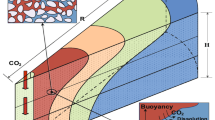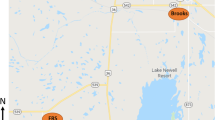Abstract
This article presents a numerical investigation of the combined effects of capillary pressure, salinity and in situ thermodynamic conditions on CO2-brine-rock interactions in a saline aquifer. We demonstrate that the interrelations between capillary pressure, salinity, dissolution and drying-out affect CO2 injectivity and storage capacity of a saline aquifer. High capillary forces require a high injection pressure for a given injection rate. Depending on salinity, the increase in injection pressure due to capillary forces can be offset by the dissolution of CO2 in formation water and its compressibility. Higher capillary forces also reduce gravity segregation, and this gives a more homogeneous CO2 plume which improves the dissolution of CO2. The solubility of CO2 in formation water decreases with increasing salinity which requires an increased injection pressure. Higher salinity and capillary pressure can even block the pores, causing an increased salt precipitation. Simulations with various pressure-temperature conditions and modified salinity and capillary pressure curves demonstrate that, with the injection pressures similar for both cold and warm basins at a given injection rate, CO2 dissolves about 10% more in the warm basin water than in the cold basin. The increase in dissolution lowers the injection pressure compensating the disadvantage of low CO2 density and compressibility for storage in warm basins.
Similar content being viewed by others
References
Bachu S.: Screening and ranking of sedimentary basins for sequestration of CO2 in geological media in response to climate change. Environ. Geol. 44(3), 277–289 (2003)
Bachu S., Bennion B.: Effects of in-situ conditions on relative permeability characteristics of CO2-brine systems. Environ. Geol. 54, 1707–1722 (2008)
Bachu S., Bennion B.: Interfacial tension between CO2, freshwater, and brine in the range of pressure from (2 to 27) MPa, temperature from (20 to 125)°C, and water salinity from (0 to 334000) mgl−1. J. Chem. Eng. Data 54, 765–775 (2009)
Bennion, B., Bachu, S.: Dependence on temperature, pressure and salinity of the IFT and relative permeability displacement characteristics of CO2 injection in deep saline aquifers. In: SPE 102138, SPE Annual Technical Conference, San Antonio, TX, 24–27 September (2006)
Bennion B., Bachu S.: Drainage and imbibition relative permeability relationships for supercritical CO2/brine and H2S/brine systems in intergranular sandstone, carbonate, shale, and anhydrite rocks. SPE Res. Eval. Eng. 11(3), 487–496 (2008)
Burton, M., Kumar, N., Bryant, S.: Time-dependent injectivity during CO2 storage in aquifers. In: SPE 113937, SPE/DOE IOR Symposium, Tulsa, OK, 19–23 April 2008
Chang, Y.B., Coats, B.K., Nolen, J.S.: A compositional model for CO2 floods including CO2 solubility in water. In: Paper SPE 365164, SPE Parmian Basin Oil & Gas Recovery Conference, Midland, TX, 27–29 March 1998
Chiquet, P., Broseta, D., Thibeau, S.: Capillary alteration of shaly caprocks by CO2. In: Paper SPE 94183, SPE/EAGE Conference, Madrid, Spain, 13–16 June 2005
Chiquet P., Daridob J.-L., Broseta D., Thibeau S.: CO2/water interfacial tensions under pressure and temperature conditions of CO2 geological storage. Energy Convers. Manag. 48, 736–744 (2007)
Cinar Y., Neal P.R., Allinson W.G., Sayers J.: Geo-engineering and economic assessment of a potential carbon capture and storage site in Southeast Queensland, Australia. SPE Res. Eval. Eng. 12(5), 660–670 (2009)
Doughty C.: Modeling geologic storage of carbon dioxide: comparison of non-hysteretic and hysteretic characteristic curves. Energy Convers. Manag. 48, 1768–1781 (2007)
Duan Z., Sun R.: An improved model calculating CO2 solubility in pure water and aqueous NaCl solutions from 273 to 533 K and from 0 to 2000 bar. Chem. Geol. 193, 257–271 (2003)
Eaton B.: Fracture gradient prediction for the new generation. SPE Reprint Series [0891-0901] 49, 108–111 (1999)
Ennis-King J., Paterson L.: Role of convective mixing in the long term storage of carbon dioxide in deep saline formations. SPE J. 10, 349–356 (2005)
Giorgis T., Carpita M., Battistelli A.: 2D modeling of salt precipitation during the injection of dry CO2 in a depleted gas reservoir. Energy Convers. Manag 48, 1816–1826 (2007)
Hebach A., Hebach A., Oberhof A., Dahmen N., Kogel A., Ederer H., Dinjus E.: Interfacial tension at elevated pressures-measurements and correlations in the water + carbon dioxide system. J. Chem. Eng. Data 47, 1540–1546 (2002)
Kopp A., Class H., Helmig R.: Investigations on CO2 storage capacity in saline aquifers—Part 1. Dimensional analysis of flow processes and reservoir characteristics. Int. J. Greenh. Gas Control 3, 263–276 (2009a)
Kopp A., Class H., Helmig R.: Investigations on CO2 storage capacity in saline aquifers—Part 2: estimation of storage capacity coefficients. Int. J. Greenh. Gas Control 3, 277–287 (2009b)
Kumar A., Ozah R., Noh G., Pope G.A., Bryant S., Sepehrnoori K., Lake L.W.: Reservoir simulation of CO2 storage in deep saline aquifers. SPE J. 10(3), 336–348 (2005)
Plug W.-J., Bruning J.: Capillary pressure for the sand–CO2–water system under various pressure conditions; application to CO2 sequestration. Adv. Water Resour. 30, 2339–2353 (2007)
Pruess, K.: TOUGH2—a general purpose numerical simulator for multiphase fluid and heat flow. Report-29400, Lawrence Berkeley National Laboratory, CA, May 1991
Pruess, K.: ECO2N—a Tough2 fluid property module for mixtures of water, NaCl and CO2. Report LBNL-57952, Lawrence Berkeley National Laboratory, CA, 2005
Pruess K., Müller N.: Formation dry-out from CO2 injection into saline aquifers: 1. Effects of solid precipitation and their mitigation. Water Resour. Res. 45, W03402 (2009a)
Pruess K., Müller N.: Formation dry-out from CO2 injection into saline aquifers: 2. Analytical model for salt precipitation. Water Resour. Res. 45, W03403 (2009b)
Pruess, K., Xu, T., Apps, J., Garcia, J.: Numerical modelling of aquifer disposal of CO2. In: SPE 66537, SPE/EPA/DOE Exploration and Production Environmental Conference, San Antonio, TX, 26–28 February 2001
Pruess K., Garcia J., Kovscek T., Oldenburg C., Rutqvist J., Steefel C., Xu T.: Code intercomparison builds confidence in numerical simulation models for geologic disposal of CO2. Energy 29(9–10), 1431–1444 (2004)
Rutqvist J., Birkholzer J.T., Tsang C.-F.: Coupled reservoir-geomechanical analysis of the potential for tensile and shear failure associated with CO2 injection in multilayered reservoir-caprock systems. Int. J. Rock Mech. Min. Sci. 45, 132–143 (2008)
Spycher N., Pruess K.: CO2–H2O mixtures in the geological sequestration of CO2. II. Partitioning in chloride brines at 12–100°C and up to 600 bar. Geochim. Cosmochim. Acta 69(13), 3309–3320 (2005)
Stauffer P.H., Viswanathan H.S., Pawar R.J., Guthrie G.D.: A system model for geologic sequestration of carbon dioxide. Environ. Sci. Technol. 43(3), 565–570 (2009)
Ülker, E.B.: Investigation of the CO2 storage capacity of aquifer structures: CO2 storage in a Buntsandstein prototype aquifer. PhD Thesis, Clausthal University of Technology, Germany (2009)
Ülker, E.B., Alkan, H., Pusch, G.: Implications of the phase-solubility behaviour on the performance predictions of the CO2 trapping in depleted gas reservoirs and aquifers. In: SPE 107189-MS SPE/EAGE Annual Conference & Exhibition, UK, 11–14 June 2007
Verma A., Pruess K.: Thermohydrologic conditions and silica redistribution near high-level nuclear wastes emplaced in saturated geological formations. J. Geophys. Res. 93(B2), 1159–1173 (1988)
Vidal-Gilbert S., Nauroy J.-F., Brosse E.: 3D geomechanical modelling for CO2 geologic storage in the Dogger carbonates of the Paris Basin. Int. J. Greenh. Gas Control 3, 288–299 (2009)
Zhou Q., Birkholzer J., Tsang C.-F., Rutqvist J.: A method for quick assessment of CO2 storage capacity in closed and semi-closed saline formations. Int. J. Greenh. Gas Control 2, 626–639 (2008)
Author information
Authors and Affiliations
Corresponding author
Rights and permissions
About this article
Cite this article
Alkan, H., Cinar, Y. & Ülker, E.B. Impact of Capillary Pressure, Salinity and In situ Conditions on CO2 Injection into Saline Aquifers. Transp Porous Med 84, 799–819 (2010). https://doi.org/10.1007/s11242-010-9541-8
Received:
Accepted:
Published:
Issue Date:
DOI: https://doi.org/10.1007/s11242-010-9541-8




